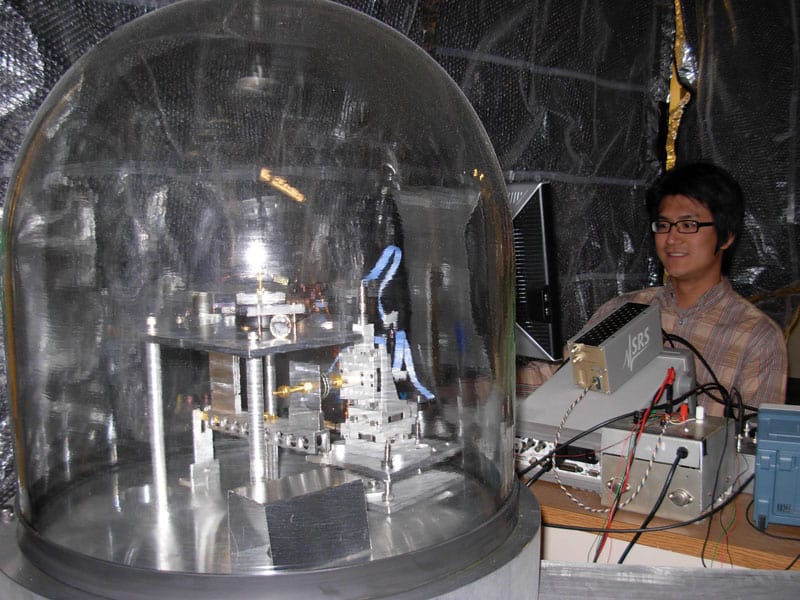Tiny Casimir torque is measured at long last
20 Dec 2018
A very subtle macroscopic effect caused by quantum fluctuations has been observed more than four decades after it was predicted. The “Casimir torque”, which causes two optically anisotropic objects to rotate relative to one another, has been seen for the first time by physicists in the US, who say that the demonstration could lead to improvements in tiny electromechanical devices and liquid crystals.
But in 1972 American physicists Adrian Parsegian and George Weiss predicted that replacing the metal plates with optically anisotropic materials could also lead to a torque between the two objects. That is because the internal asymmetry of each plate would change the boundary conditions of the cavity when one is rotated relative to the other. The torque would arise spontaneously, causing a rotation that would stop when the cavity reaches its lowest energy state.Physicists know that quantum fluctuations in the vacuum can give rise to what is known as the Casimir force. Predicted by Dutch physicist Hendrik Casimir in 1948, this arises between two uncharged parallel metal plates placed within a micron of each other such that they create an optical cavity that restricts the number of different electromagnetic waves that can exist between them. The higher density of waves, and hence energy, outside the plates leads to a tiny net force that pushes the plates inwards.
Realigned gratings
One very simple optically anistropic material is a grating. If two gratings are aligned parallel to one another they trap a limited number of electromagnetic waves – those with the right wavelengths and polarization to bounce back and forth between the gratings’ strips. But if positioned at right angles to one another the gratings do not trap any waves. This means that all waves can exist between the gratings, just as they do outside of them. And because this leads to a higher energy density between the two objects the Casimir torque will cause them to realign.
This effect has now been experimentally confirmed by Jeremy Munday and colleagues at the University of Maryland, College Park, thanks to a novel combination of anisotropic materials – one a solid and the other a liquid crystal. As Munday explains, it is hard to bring two relatively large flat objects close to one another without them touching, and as such most experiments measure the Casimir force between a plate and a sphere. However, he says, fashioning a sphere from an optically anisotropic material – such as a birefringent crystal – is very difficult to do.
This means that most attempts to measure the Casimir torque have reverted to the two-plate system. These experiments typically rely on a pair of solid birefrigent crystals, materials whose refractive index depends on the polarization and direction of an incoming light beam. However, in addition to the original problem of alignment, says Munday, these systems face a second challenge – how to rotate one crystal relative to the other.
Liquid solution
The new experiment overcomes this problem by replacing one of the solid crystals with a nematic liquid crystal. The idea is that the liquid crystal serves as both an isotropic medium and as a torque sensor. The rod-shaped molecules at one end of the liquid crystal are fixed in place while those at the other end are rotated by the Casimir torque, given the presence of the birefringent solid some fixed (small) distance away.
This set-up twists the liquid crystal, which means that a polarized light beam fired through the solid and then liquid crystals has it axis of polarization rotated. The researchers work out this rotation by measuring the intensity of the light after it passes through a second polarizer, and then use the known elastic properties of the liquid crystal to calculate the Casimir torque.
The team measured the torque using four different brirefringent crystals – calcite, lithium niobite, rutile and yttrium vanadate – while varying the orientation of the crystal’s optical axis and the distance from the liquid crystal. The variation in torque almost exactly matched that predicted by theory. “We didn’t know the optical properties for the materials we used over all frequencies,” says Munday. “But for the data we did have the experimental and theoretical results agree very well with each other.”
Macroscopic quantum effect
Munday points out that the Casimir torque is “one of the few macroscopic manifestations of a quantum effect,” and reckons its discovery could have practical applications – such as reducing unwanted rotations within micromechanical devices and the creation of very sensitive rotation sensors.READ MORE

The research is described in Nature. In an accompanying commentary piece, Slobodan Žumer of the University of Ljubljana and Jožef Stefan Institute in Slovenia agrees that the demonstration “paves the way for the development of complex micrometre- and nanometre-scale mechanical devices.” But he adds that it might be possible to find liquid crystals that experience greater torque and are more easily twisted.
Munday explains that he and his colleagues used a very common liquid crystal called 5CB to minimize unknown effects. The team is now investigating more obscure but potentially more anisotropic materials. He adds that they are also extending the inter-crystal distance beyond their current maximum of 40 nm, in part to establish whether – as predicted theoretically – an increase in separation can flip the direction of rotation for certain pairs of birefringent materials.
Edwin Cartlidge is a science writer based in Rome
21/12/2018 from physicsworld.com

Δεν υπάρχουν σχόλια:
Δημοσίευση σχολίου